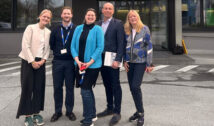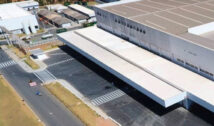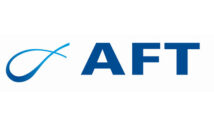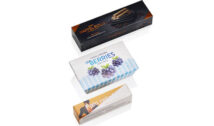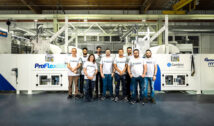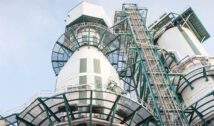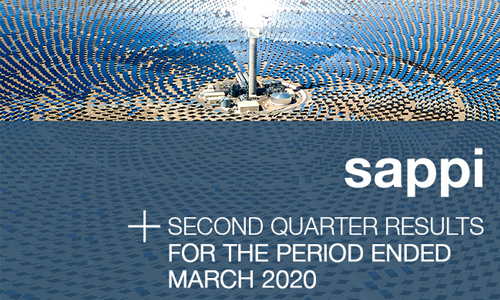
Covid-19
Commenting on the impact of Covid-19, Sappi Chief Executive Officer, Steve Binnie said: “The impact of Covid-19 on people, business and society has been severe. Sappi’s approach to the outbreak of Covid-19 is guided by our values and purpose. Our priority remains the safety of our people across all of the territories where they are present. This ensures that our operations continue in a safe and uninterrupted manner. We remain in close contact with our customers and suppliers as we try to minimise any negative impacts within government constraints, helping local economies to mitigate the negative economic consequences of the various measures imposed. We also assist with efforts to help mitigate the impact of the virus on local communities. I am proud of the Sappi team around the world who are living our values, being innovative and taking initiative to help our stakeholders. We understand that overcoming the impact of Covid-19 and returning to normal business operations will require significant time and effort, for which we are preparing.
Turning to the impact of Covid-19 on the second quarter, he continued: “Covid-19 had a relatively small impact on profitability during the quarter. However, an anticipated improvement in dissolving pulp (DP) prices did not materialise, principally as a result of the outbreak of Covid-19 in China. The subsequent actions taken by various governments only directly impacted our operations during the last few weeks of the quarter, and there was minimal disruption to production, although the Condino Mill in Italy was temporarily shut. We began to receive significant cancellations of DP and graphic paper orders scheduled to be delivered in the third quarter, and new orders for both product categories slowed considerably.”
Q2 financial results
Commenting on the quarter’s results, Binnie said: “I am very pleased with the strong packaging and specialities performance which saw EBITDA contribution almost double. I am also pleased with the solid results in the graphics paper segment, as well as the significant increase in market share across both segments. Despite these strong performances, the results were negatively impacted due to the historic low dissolving pulp (DP) prices, and reduced DP sales volumes.”
Financial summary for the quarter
- EBITDA excluding special items US$131 million (Q2 FY19 US$187 million)
- Profit for the period US$2 million (Q2 FY19 US$72 million)
- EPS excluding special items 4 US cents (Q2 FY19 13 US cents)
- Net debt US$1,879 million (Q2 FY19 US$1,680 million)
DP market prices fell US$233/ton in the last twelve months as the combined impact of soft global textile markets, US duties on textiles from China, excess viscose staple fibre (VSF) capacity and a weaker US$/Renminbi exchange rate drove the DP price downwards. On the supply side, low paper pulp prices provided limited relief for swing producers. This significantly impacted both the segment and group profitability levels.”
Our strategy to diversify the product portfolio into higher margin segments and position the company for future growth continues to bear fruit. The packaging and specialities segment continued to grow profitability despite slow containerboard demand in South Africa. Improved product mix and machine efficiencies combined with lower input costs and increased sales volumes in Europe and North America contributed positively. The ramp up of Somerset Mill PM1 and Maastricht Mill on paperboard grades further assisted us to significantly reduce commercial downtime compared to the prior year.
Strong customer relationships and service levels, along with a focus on efficiencies and costs enabled us to make significant market share gains in our graphics paper business, and as a result helped maintain profitability in this segment, despite weak market conditions.
Sales volumes for packaging and specialities in Europe increased by 5% on the prior year, with food and hygiene related packaging experiencing especially strong demand. In North America sales volumes for packaging and specialities grew 68% year-on-year, and 49% versus the prior quarter, driven mainly by the ramp up of the paperboard grades on PM1 at Somerset Mill as well as strong growth in label paper volumes. In South Africa the containerboard sales volumes recovered from the first quarter, but still 4% below the prior year. A recovery in demand is expected later in the season. The market share gains in coated woodfree paper in both North America and Europe countered the ongoing deterioration in graphic paper demand, enabling us to take fewer production curtailments than in recent quarters. Declining input costs helped maintain healthy margins.
Outlook
As we indicated in the Covid-19 update issued on 30 March 2020, we will not be providing a profit forecast or guidance as the potential impact of the virus cannot be estimated reliably. We continue to apply all health and safety precautions to ensure that our people are safe and our operations are able to continue in a safe and uninterrupted manner, including in South Africa, where our operations have been declared an essential service. We do, however, expect significantly lower demand for DP and graphic paper in the short term. The group’s focus is to preserve liquidity and cash flow and we have implemented various cost saving measures across our operations, curtailed excess production and where possible deferred non-essential capital expenditure and applied measures to optimise working capital.
Current liquidity headroom in the group is strong, with cash deposits at the end of the quarter of US$268 million and two undrawn revolving credit facilities of approximately US$642 million. In light of the uncertainty regarding future trading conditions and to ensure we have adequate liquidity for the duration of this difficult period, we negotiated the suspension of our credit facility financial covenants as announced to the market.
The various lockdown regulations and actions taken in different countries across the globe have severely impacted clothing retailers and many have been forced to shut stores for an extended duration. In conjunction with reduced consumer confidence and spending as a result of the pandemic, this has led to reduced textile demand throughout the supply chain and ultimately resulted in our major DP customers notifying us of their intention to reduce orders in the third quarter. In April our sales volumes were approximately 35% lower than planned. As a result, we will reduce DP production at each of our mills to lower costs and maximise the opportunity to produce paper pulp at Cloquet and Ngodwana Mills to mitigate the impacts on profitability. Some additional DP sales volumes may be placed in China as domestic supply has been limited due to switching of DP producers to various grades of paper pulp.
The packaging and specialities segment continues to grow, and with much of our volumes sold into the food and hygiene sector, should be more resilient during the crisis. The recent conversions will continue to ramp-up, however testing for new customers may be delayed somewhat by the lockdown. South African containerboard sales have also been positively affected in April, and the citrus season outlook is encouraging at this stage.
April sales for graphic paper were materially weaker, with volumes 27% lower in Europe and North America. The lockdown in South Africa has also had a severe impact on newsprint and office paper volumes. This has necessitated extensive downtime on various machines in all regions, with certain staff in Europe and North America being placed on temporary economic unemployment in order to reduce fixed costs. Paper prices have to date not shown any material weakness as a result, and variable cost trends are favourable.
A number of steps have been taken to reduce capital expenditure for the remainder of 2020. As a result of the force majeure declaration the Saiccor Mill expansion project is likely to only be completed in FY2021. We have also postponed all remaining material discretionary projects and shifted annual maintenance shuts as late as possible. As a result, we now expect capital expenditure for the remainder of fiscal 2020 to be approximately US$200 million.



